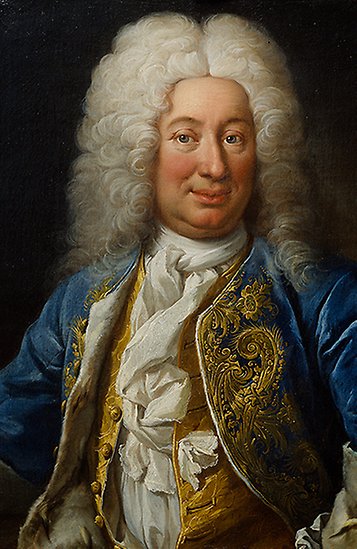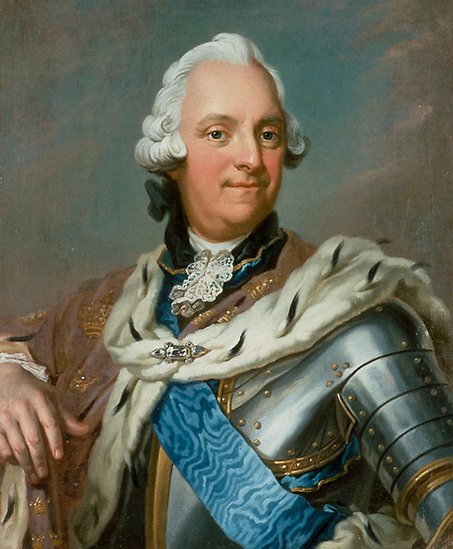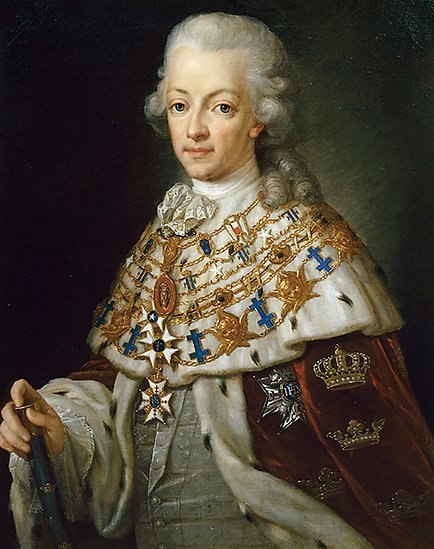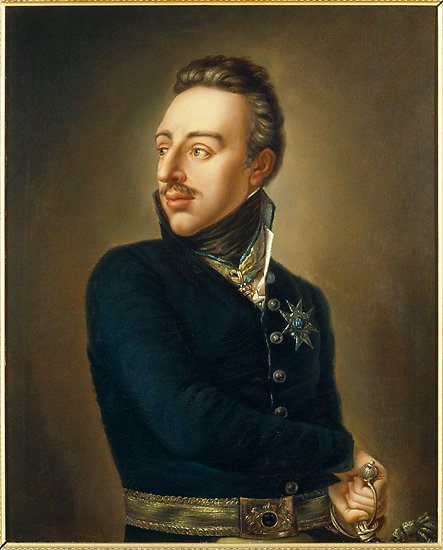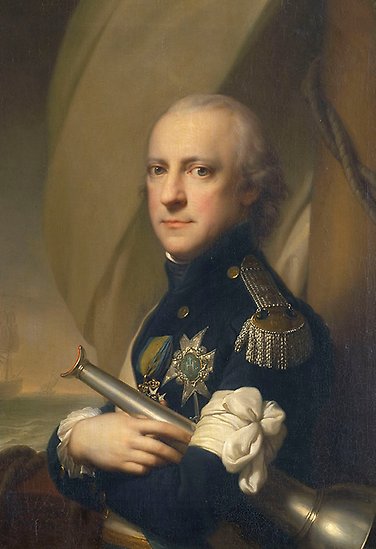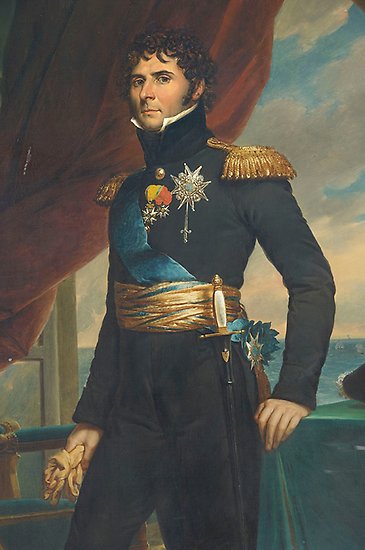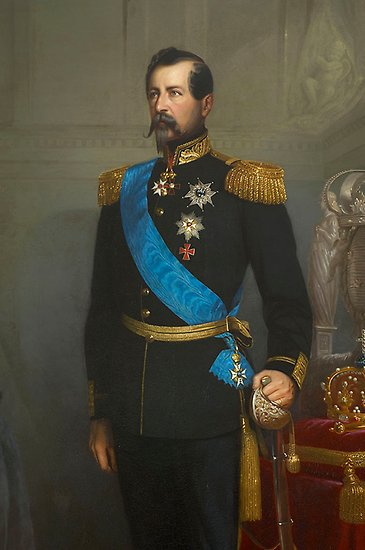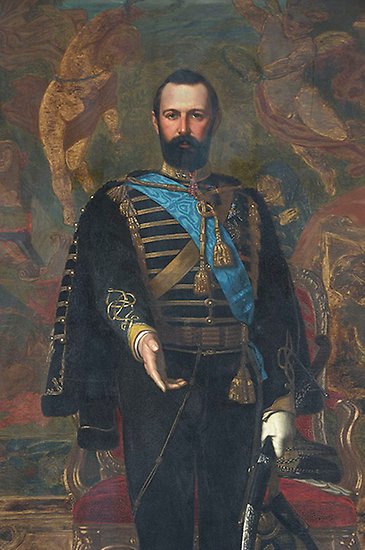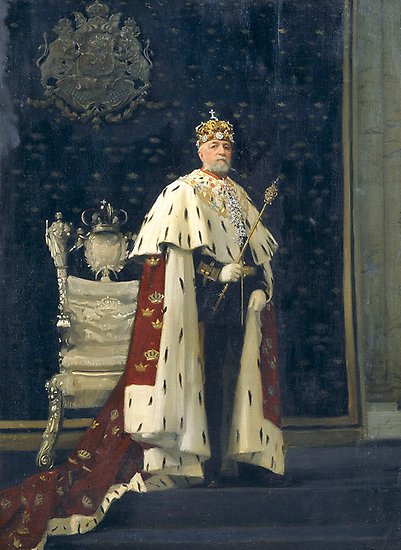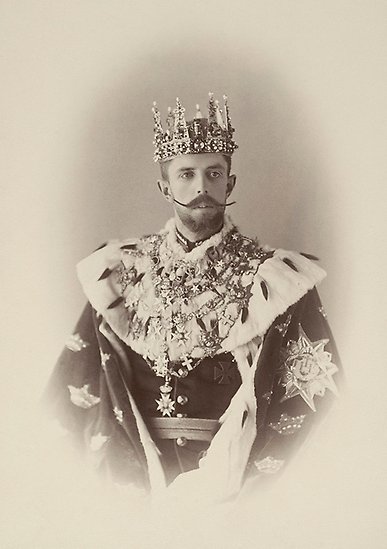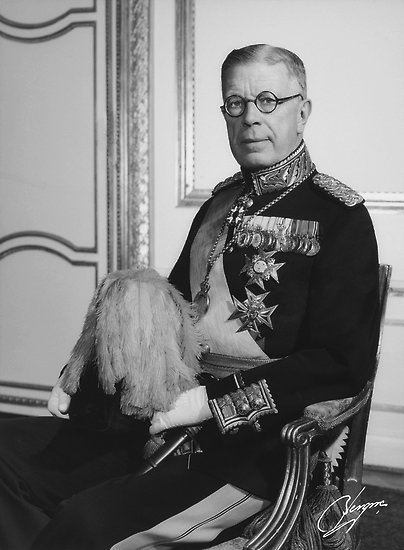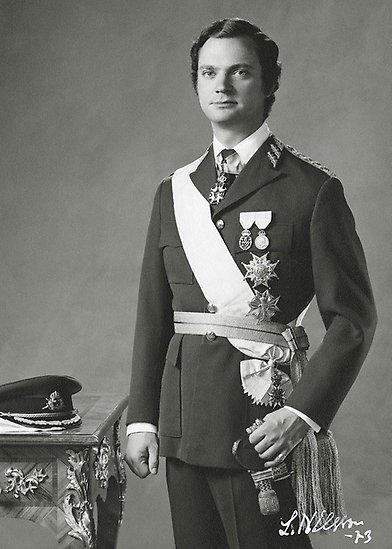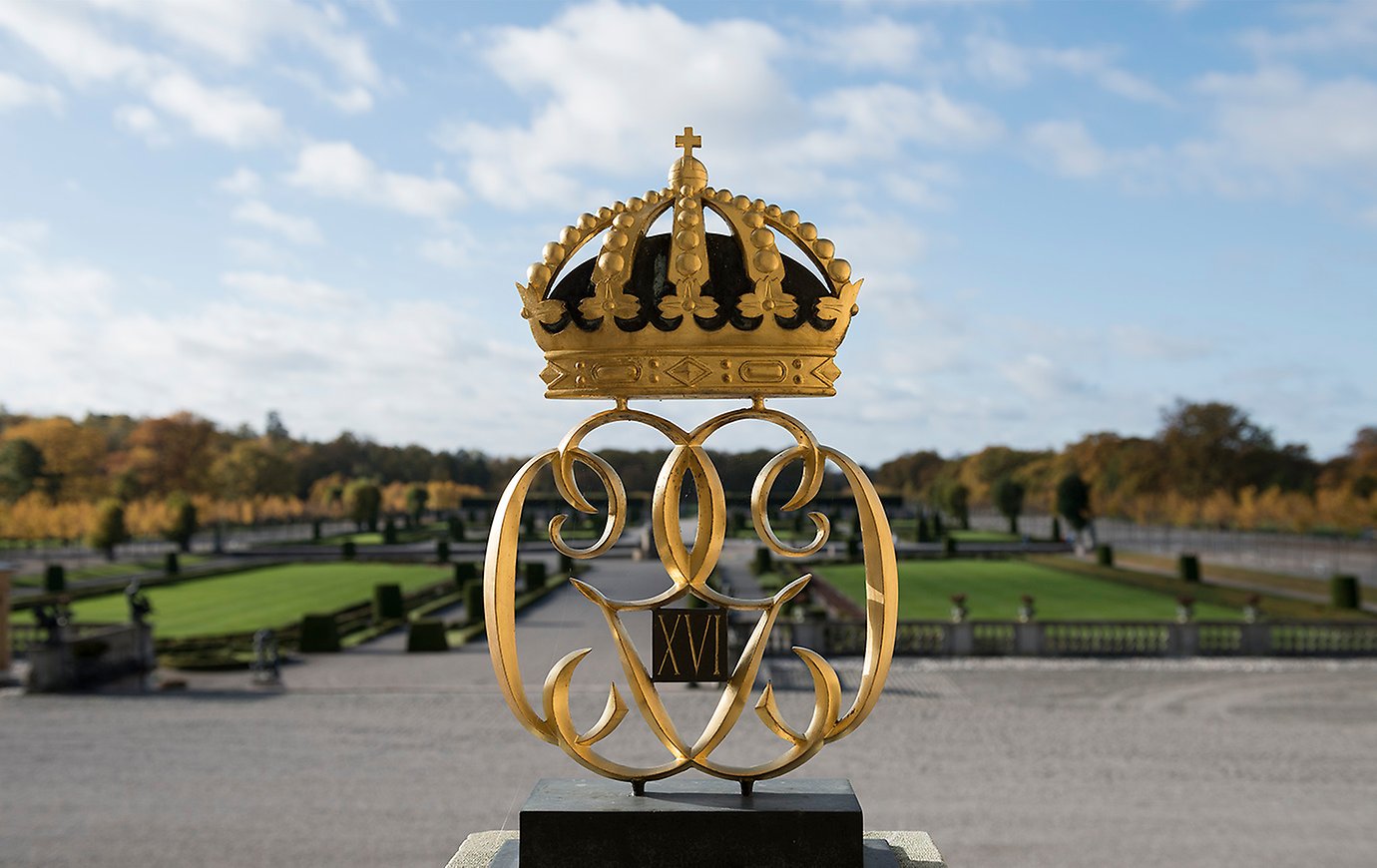The monarchy of Sweden
The Swedish monarchy dates back more than a thousand years, and represents both continuity and tradition. Over the centuries, its role has changed in line with the rest of society. Our current king is Sweden's longest reigning monarch, and his motto is "For Sweden – With the Times".
Sweden's form of government
Sweden's form of government
The Swedish monarchy dates back more than a thousand years, and represents both continuity and tradition. Over the centuries, its role has changed in line with the rest of society. Our current king is Sweden's longest reigning monarch, and his motto is "For Sweden – With the Times".
Sweden is a constitutional monarchy, which means that HM The King is the country's Head of State and his duties are regulated by law. The fact that Sweden should have a king or a queen regnant as its head of state is established in the Instrument of Government – one of the kingdom's constitutional laws. As a non-political Head of State, the monarch is a unifying representative of Sweden and a symbol of the country.
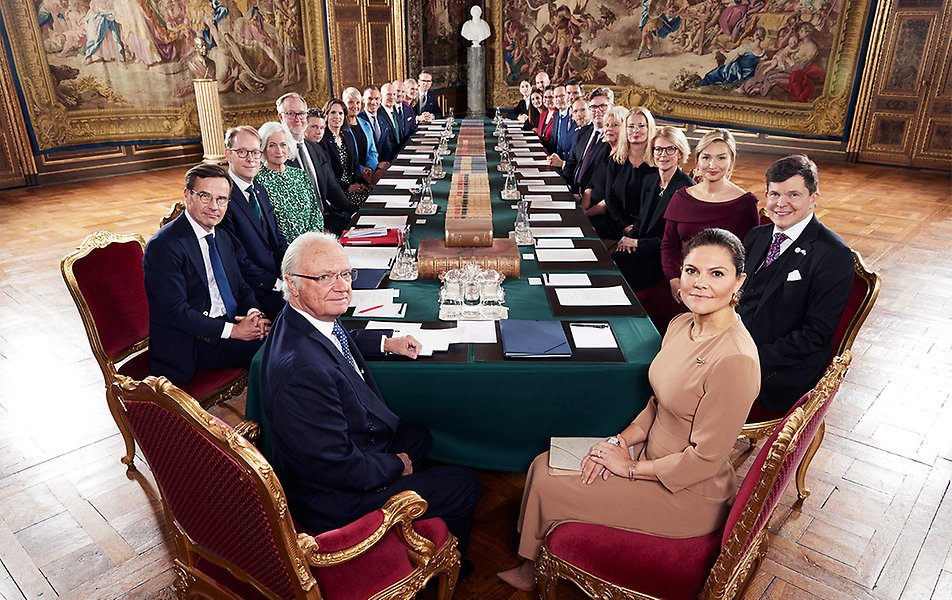
A Change of Government Council chaired by HM The King at the Royal Palace in 2022. The Council was attended by The Crown Princess, the Speaker of the Riksdag and the new Government. Photo: Ingemar Lindewall/The Royal Court of Sweden
Sweden has been a continuous monarchy since the 10th century, making it unique in the world with its historical and cultural heritage stretching back more than a thousand years. Although the role of the Head of State has changed with the development of society, the monarchy represents continuity and tradition – which is of growing importance in a rapidly changing world. Sweden's current king, Carl XVI Gustaf, ascended to the throne on 15 September 1973 and is the country's 74th monarch.
The King carries out his duties in accordance with his motto, "For Sweden – With the Times", which involves promoting Swedish interests and being attentive to the many efforts made in and for Sweden.
Full cognatic succession
The line of succession is determined by the order of succession, which is one of Sweden's four constitutional laws. Having had an agnatic (male) line of succession since the beginning of the 18th century, a fully cognatic line of succession was introduced in 1980. As a result of this change – which Sweden was the first country to introduce – the monarch's oldest child inherits the throne.
The King's duties
The King's duties
As Head of State, The King primarily has state ceremonial and official duties, and can shape his own duties within the framework set out in the Instrument of Government.
The King's duties include:
- Opening the Parliamentary Session at the request of the Speaker of the Riksdag. This normally happens every September, and marks the beginning of the parliamentary working year. The ceremony is held in the Riksdag's assembly hall, where The King also gives a speech to the members of the Riksdag.
- Chairing meetings that take place at the Royal Palace. A Change of Government Council is held when a new Government takes up its duties. Councils of State are held regularly to give ministers the opportunity to inform the Head of State and the heir to the throne about the Government's policies. In the event of a birth within the Royal Court, The King also convenes the Government for a council to announce the child's name and title.
- Chairing the Advisory Council on Foreign Affairs, a body for foreign policy deliberations between the Government and the Riksdag. The Council meets at the Royal Palace.
- Carrying out state visits. The King represents Sweden during incoming and outgoing state visits. State visits build personal relationships between countries, and aim to increase exchanges within various areas. They are planned in consultation with the Government, in particular the Ministry for Foreign Affairs, and signify good relations between the nations involved. State visits are also important for raising awareness of Sweden abroad. Royal involvement gives state visits a ceremonial element, and opens many doors for promoting Swedish interests abroad.
- Each year, the King receives 30 to 40 newly appointed foreign ambassadors at formal audiences. As part of this traditional ceremony, the ambassador travels in a carriage from the Ministry of Foreign Affairs to the Royal Palace and is received there by the Head of State during a formal audience. According to international practice, incoming ambassadors cannot formally work in a country until they have submitted their credentials to the host country's head of state. These credentials are a form of authorisation issued by a country's head of state for the ambassador who has been appointed to represent his or her country abroad. The King also receives ambassadors at farewell audiences when their posting in Sweden comes to an end.
Promoting Swedish interests
The King works to promote Swedish interests and has an extensive representative programme in Sweden. This is planned based on both The King's own initiatives and a large number of requests to attend various events within different sectors of society. Other members of the Royal Family actively support The King in his role as Head of State.
The King's official programme activities span a range of different areas:
- foreign relations with representatives from other countries
- domestic relations with representatives from local, regional and national authorities and organisations
- relations with Swedish industry
- the defence of the nation
- nature and environmental science, research and culture
- charities through the royal foundations
State visits
State visits
The King and Queen have carried out state visits to many of the world's countries. A state visit is the highest form of visit between two countries, and involves two heads of state meeting each other formally to strengthen relations between the countries.
.jpg)
The arrival ceremony during the state visit to India in December 2019. Photo: The Swedish Embassy in New Delhi
State visits aim to lay the foundations for strengthened personal contacts and increased political, trade and cultural exchanges between the countries involved. State visits are also accompanied by government ministers and a business delegation.
- Ceremonial traditions
The programmes for state visits usually last for two or three days, and follow the country's traditions and ceremonial patterns. Most state visits begin with ceremonies and other official elements on the first day.
In the case of incoming state visits, the visiting head of state is met by The King and Queen at the Royal Stables before travelling by horse and carriage to the Royal Palace for the official welcoming ceremony. The day also includes a private lunch at the Royal Palace, a meeting with the Speaker of the Riksdag and the Prime Minister, and a gala dinner at the Royal Palace.
Day two usually includes a number of trade and culture promotion events in Stockholm, and sometimes lunch at Stockholm City Hall. It is also customary for the visiting country to host a reciprocal dinner or a similar event in the evening.
The third day of the state visit is normally spent at another location in Sweden.
Outgoing state visits follow much the same pattern in the host country.
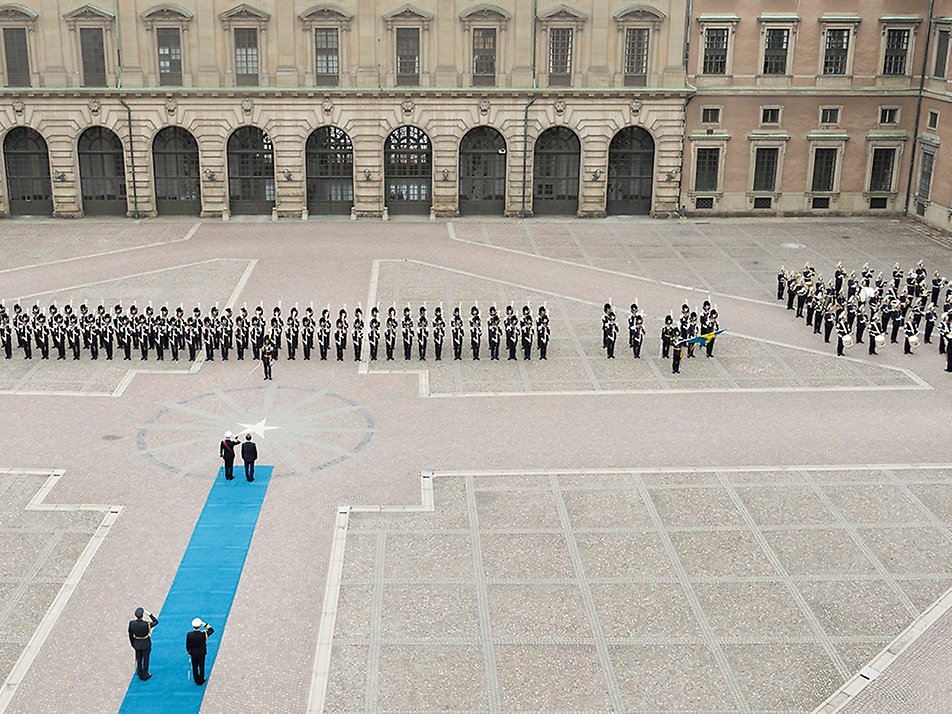
A state visit to Sweden includes several ceremonial elements, including a welcoming ceremony in the Inner Courtyard of the Royal Palace. Photo: Emma Henriksson/The Royal Court of Sweden
State visits 1974-2023
A list of all outgoing and incoming state visits from the King's accession to the throne in 1973 until today.
Date | Incoming | Outgoing | Comment |
|---|---|---|---|
1974 | |||
8–10 October | Kingdom of Norway His Majesty King Olav V | ||
9–22 November | Republic of Finland President Urho Kekkonen | ||
1975 | |||
10–12 April | Kingdom of Danmark Her Majesty Queen Margrethe II His Royal Highness Prince Henrik | ||
10–13 June | Republic of Island President Dr. Kristján Eldjárn | ||
8–11 July | United Kingdom Her Majesty Queen Elizabeth II and His Royal Highness The Duke of Edinburgh | ||
21–24 October | Republic of Finland President Urho Kekkonen | ||
25–27 November | Kingdom of Norway His Majesty King Olav V | ||
1976 | |||
29–30 March | Federal People's Republic of Yugoslavia President Josip Broz Tito | ||
18–19 May | Republic of Austria Federal President | ||
Date | Incoming | Outgoing | Comment |
|---|---|---|---|
1976 cont. | |||
25–28 October | Kingdom of the Netherlands | ||
1977 | |||
15–17 March | Kingdom of Belgium | ||
1978 | |||
7–15 June | Union of Soviet Socialist Republics | ||
11–15 September | Federal People's Republic of Yugoslavia President Tito | ||
1979 | |||
20–27 March | Federal Republic of Germany | ||
16 –19 October | Kingdom of Spain | ||
6–9 November | Republic of Austria | ||
1980 | |||
13–19 April | Japan | ||
22–25 May | United Mexican States | ||
16–18 June | French Republic | ||
6–10 November | Romania | ||
1981 | |||
9–14 February | United Republic of Tanzania | ||
20–24 February | The Kingdom of Saudi Arabia | ||
18–20 May | Canada | ||
14–23 September | People's Republic of China | ||
26–29 October | Republic of Iceland | ||
1982 | |||
18–23 January | United Mexican States | ||
28 March–6 April | The Commonwealth of Australia | Only HM The King attended | |
27–29 April | Republic of Finland | ||
1983 | |||
22–24 March | Kingdom of Spain | ||
25–28 May | United Kingdom | ||
22–25 August | Republic of Finland | ||
21–23 September | Grand Duchy of Luxemburg | ||
1984 | |||
2–7 April | Federative Republic of Brazil | ||
16–18 May | French Republic | ||
3–6 October | Hashemite Kingdom of Jordan Their Majesties King Hussein and Queen Noor | ||
1985 | |||
12–14 February | Republic of Zambia | ||
22–24 April | Swiss Confederation | ||
4–6 June | Japan | Official visit | |
3–6 September | The Kingdom of Denmark | ||
1986 | |||
22–24 April | People's Democratic Republic of Algeria | ||
29 September –5 October | Portuguese Republic | ||
1–6 November | Arab Republic of Egypt | ||
1987 | |||
21–23 May | Kingdom of the Netherlands | ||
23–26 June | Republic of Iceland | ||
1988 | |||
14–18 March | Canada | ||
31 May–3 June | Federal Republic of Germany | ||
1989 | |||
11–17 February | New Zealand | ||
18–25 September | Hashemite Kingdom of Jordan | ||
1990 | |||
21–23 May | State of Israel | ||
9–12 October | Portuguese Republic | ||
1991 | |||
8–10 April | Italian Republic | ||
2–4 May | State of the Vatican City | ||
22–24 May | The Czech and Slovak Federal Republic | ||
27–30 May | Republic of Hungary | ||
15–17 October | Grand Duchy of Luxembourg | ||
1992 | |||
7–9 April | Ireland | ||
22–24 April | Republic of Estonia | ||
12–14 May | Kingdom of Norway | ||
9–11 September | Republic of Latvia | ||
15–17 October | Republic of Lithuania | ||
1993 | |||
27–29 April | Federal Republic of Germany | Official visit | |
7–9 June | Kingdom of Norway | ||
22–24 September | Republic of Poland | Only HM The King attended | |
11–16 October | Republic of India | ||
1994 | |||
13–15 April | Republic of Finland | ||
3–5 May | Kingdom of Belgium | ||
1995 | |||
29–31 March | Republic of Poland | Only HM The King attended | |
16–18 May | Czech Republic | ||
11–13 September | Republic of Estonia | ||
16–18 October | Republic of Latvia | ||
21–23 November | Republic of Lithuania | ||
1996 | |||
12–16 March | Malaysia | HRH Prince Carl Philip attended | |
28–30 August | Republic of Finland | HRH The Crown Princess attended | |
1–3 October | Republic of Hungary | ||
2–6 December | Republic of Chile | ||
1997 | |||
18–20 February | Republic of South Africa | ||
15–17 April | Ireland | ||
23–25 September | Republic of Austria | ||
2–4 December | Russian Federation | ||
1998 | |||
5–8 May | Italian Republic | ||
26–28 May | Argentine republic | ||
3–6 November | Republic of Mozambique | ||
24–26 November | Republic of Iceland | ||
1999 | |||
17–18 March | Republic of South Africa | ||
23–25 March | Ukraine | ||
26–29 April | Greece – Hellenic Republic | ||
5–7 October | Republic of Slovenia | ||
2000 | |||
10–11 April | French Republic | ||
2–3 May | Republic of Finland | ||
29–31 May | Japan | ||
9–11 November | Republic of Bulgaria | ||
2001 | |||
8–11 May | Kingdom of Belgium | ||
8–11 November | Russian Federation | ||
2002 | |||
3–5 April | Republic of Slovenia | ||
5–7 November | United Mexican States | ||
2003 | |||
25 February– | Kingdom of Thailand | ||
8–10 April | Romania | ||
20–22 May | Federal Republic of Germany | ||
26–28 August | Republic of Finland | ||
7–9 October | Hashemite Kingdom of Jordan | ||
2004 | |||
2–6 February | Socialist Republic of Vietnam | ||
7–9 February | Negara Brunei Darussalam | ||
15–17 June | Republic of Slovenia | ||
7–9 September | Republic of Iceland | ||
2005 | |||
17–19 February | Kingdom of Thailand | Official visit | |
31 March–1 April | Republic of Latvia | ||
14–15 September | Malaysia | ||
7–12 November | Commonwealth of Australia | ||
2006 | |||
21–23 March | Republic of Botswana | ||
30 May–1 June | Republic of Turkey | ||
17–22 Juli | People's Republic of China | ||
24–27 October | Canada | ||
2007 | |||
26–29 March | Japan | ||
9–11 May | Kingdom of Denmark | HRH The Crown Princess attended | |
8–10 June | People's Republic of China | ||
11–12 September | Federative Republic of Brazil | ||
9–11 October | Republic of Bulgaria | ||
20–22 November | Republic of Austria | ||
2008 | |||
11–12 March | Romania | ||
15–17 April | Grand Duchy of Luxembourg | ||
5–7 May | Portuguese Republic | ||
20–22 May | Greece – Hellenic Republic | ||
30 September – 3 October | Ukraine | ||
2009 | |||
24–26 March | Italian Republic | ||
20–22 April | Kingdom of the Netherlands | ||
2010 | |||
23–26 March | Federative Republic of Brazil | ||
2011 | |||
18–20 January | Republic of Estonia | ||
22–25 March | Republic of Botswana | Only HM The King attended | |
4–6 May | Republic of Poland | ||
2012 | |||
17–18 April | Republic of Finland | ||
30 May – 1 June | Republic of Korea | ||
2013 | |||
11–13 March | Republic of Turkey | ||
16–18 April | Republic of Croatia | ||
1–3 October | Portuguese Republic | ||
2014 | |||
25–26 March | Republic of Latvia | ||
2–4 December | French Republic | ||
2015 | |||
3–5 March | Republic of Finland | ||
31 May–2 June | Republic of India | ||
7–9 October | Republic of Lithuania | ||
4–6 November | Republic of Tunisia | ||
2016 | |||
10–12 May | Republic of Chile | ||
8–10 June | Kingdom of Bhutan | ||
5–8 October | Federal Republic of Germany | ||
2017 | |||
20–23 February | Canada | ||
22–24 May | Republic of Indonesia | ||
2018 | |||
17–19 January | Republic of Iceland | ||
13–15 November | Italian Republic | ||
2019 | |||
22–24 May | Ireland | ||
14–15 June | Republic of Korea | ||
2–6 December | Republic of India | ||
2021 | |||
7–9 September | Federal Republic of Germany | ||
24–25 November | Kingdom of Spain Felipe VI and Queen Letizia | ||
2022 | |||
17–18 May | Republic of Finland | ||
11–13 October | Kingdom of the Netherlands Their Majesties King Willem-Alexander and Queen Máxima | ||
15–17 November | Hashemite Kingdom of Jordan | ||
2023 | |||
2–4 May | Republic of Estonia President Alar Karis and Mrs Sirje Karis | ||
2024 | |||
30–31 January | French Republic President Emmanuel Macron and Mrs Brigitte Macron | ||
12–14 March | Republic of Mexico | ||
23–24 April | Finland President Alexander Stubb and Mrs Suzanne Innes-Stubb | ||
- Official visits
An official visit is a slightly lower form of visit between two countries. Every year, The Crown Princess and Prince Daniel conduct official visits abroad at the request of the Government. These official visits also include government ministers, and usually a business delegation. The King and Queen can also carry out official visits. These visits often have the same content as a state visit, but with a slightly less formal structure.
The history of the monarchy
The history of the monarchy
Sweden's monarchy is one of the oldest in the world, and is based on traditions that stretch back over a thousand years. There have been more than 70 monarchs during this period, all of whom can be named.
With the introduction of Christianity, royal power was gradually strengthened. During the Middle Ages, royal power was not hereditary in a formal sense. The nobility and the privileged classes came into being in the late 13th century. At the same time, Sweden also gained a council, a kind of government. From this point, the country thus had central power in the form of a king and a council. The Swedish hereditary monarchy was established in the 16th century.
Several different dynasties have since been included in the list of Swedish monarchs. Since the former French marshal Jean Baptiste Bernadotte, Sovereign Prince of Ponte Corvo, ascended to the throne in 1818 as King Karl XIV Johan, the Bernadotte dynasty has ruled Sweden.
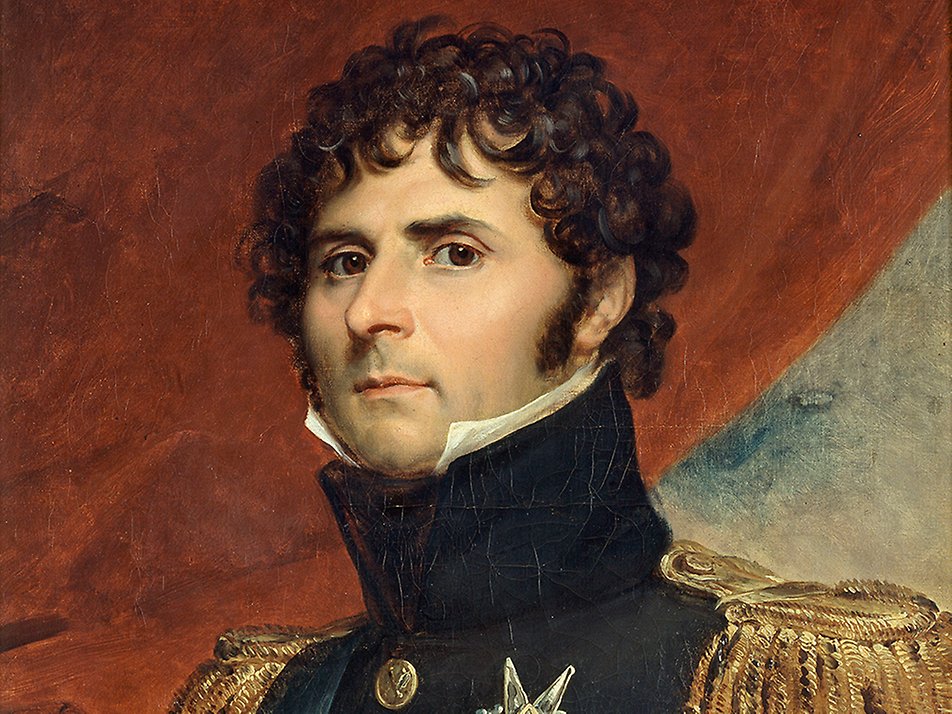
King Karl XIV Johan. Artist: François Gérard. Photo: Alexis Daflos/The Royal Court of Sweden
Symbols
Symbols
The crown, the sceptre, the orb and the key of the realm – the Swedish Royal Regalia – symbolise the traditions of the kingdom.
The Regalia indicate royal rank at major royal ceremonies such as enthronements, christenings, weddings and funerals.
The royal symbols also include the greater and lesser national coats of arms. The national coats of arms symbolise the Swedish state. The greater coat of arms is also The King's personal coat of arms.
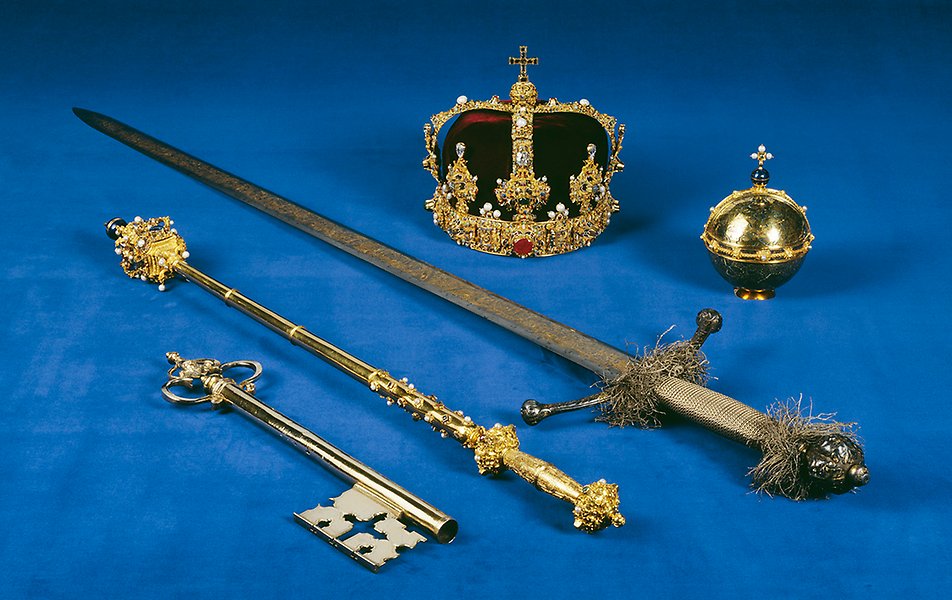
The main regalia (from left): the key, the sceptre, the sword, the crown and the orb. Photo: Alexis Daflos/The Royal Court of Sweden
Orders and medals
Orders and medals
Orders and medals allow the Head of State to recognise outstanding contributions for the benefit of society.
Since the Head of State is the country's supreme representative, these awards are an expression of the country's gratitude, and are therefore very much appreciated.
The King awards the Order of the Seraphim, the Order of the Sword, the Order of the Polar Star and the Order of Vasa to Swedes, foreign citizens and stateless individuals.
The King awards five royal medals to Swedish citizens, with HM The King's Medal being the most commonly awarded and consisting of eight levels.
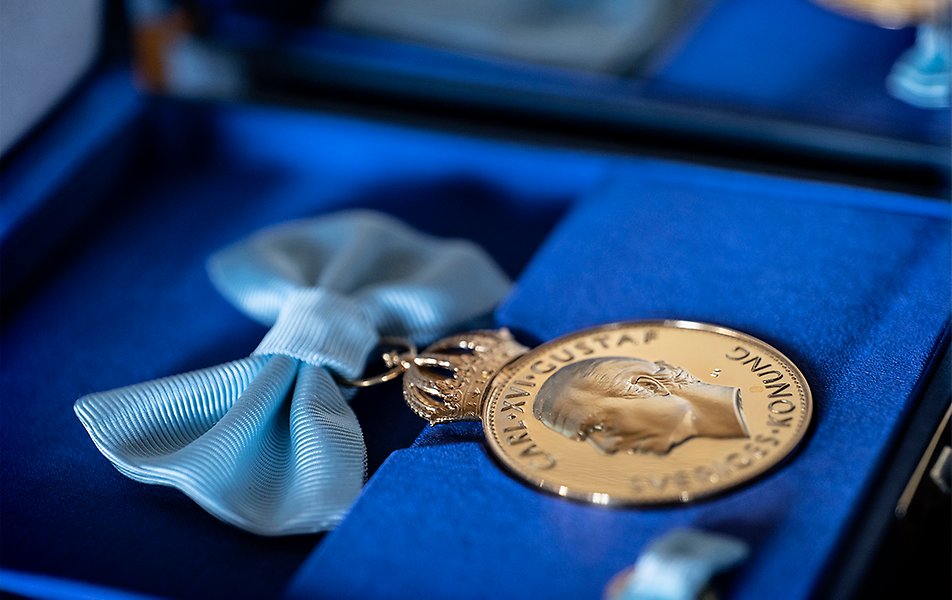
HM The King's Medal in gold in 12th size, with the ribbon of the Order of the Seraphim. Photo: Jonas Borg/The Royal Court of Sweden
The Monarchs of Sweden
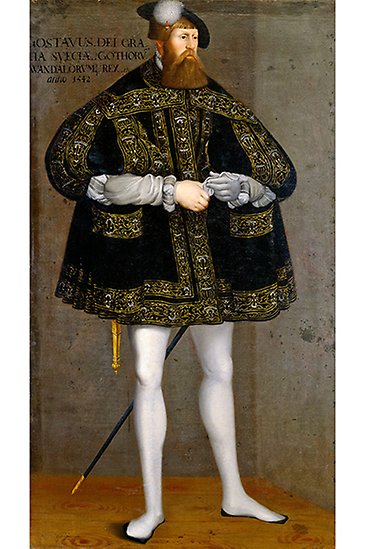
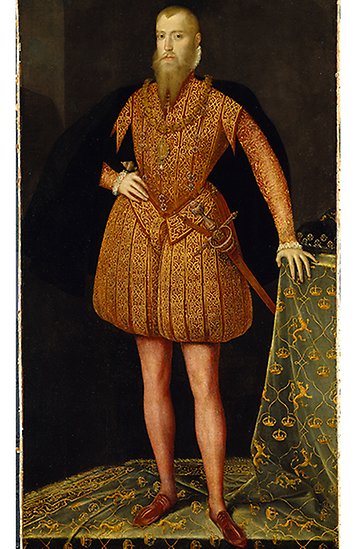
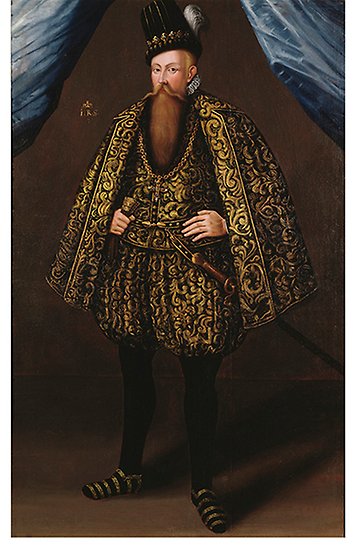
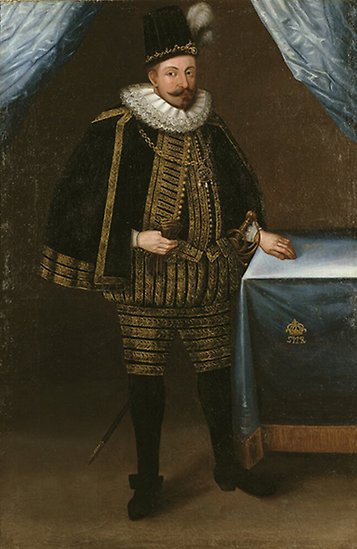
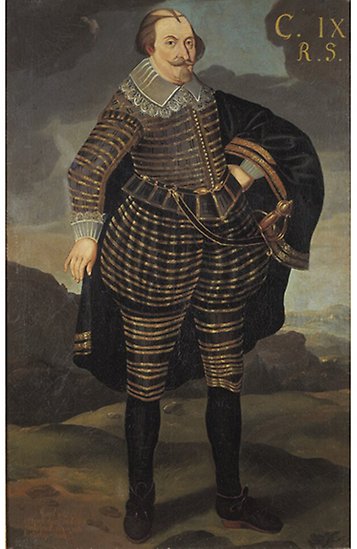
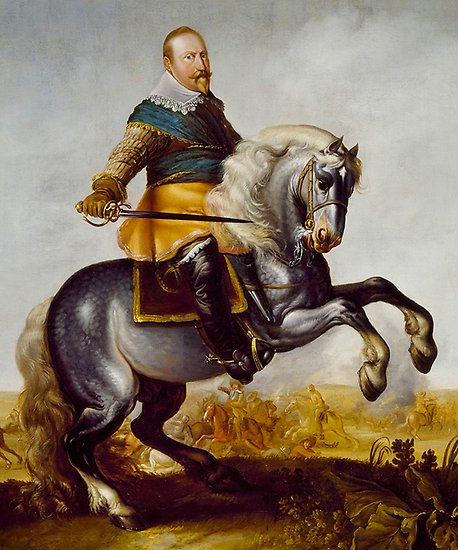
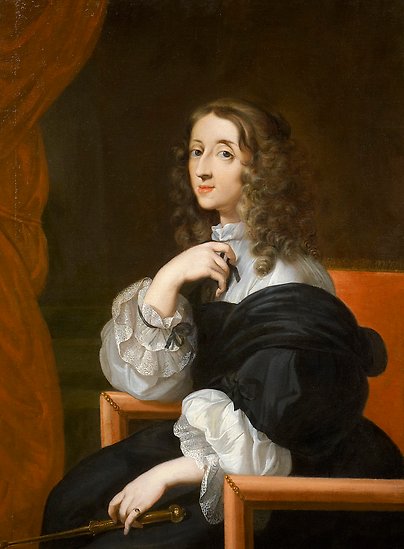
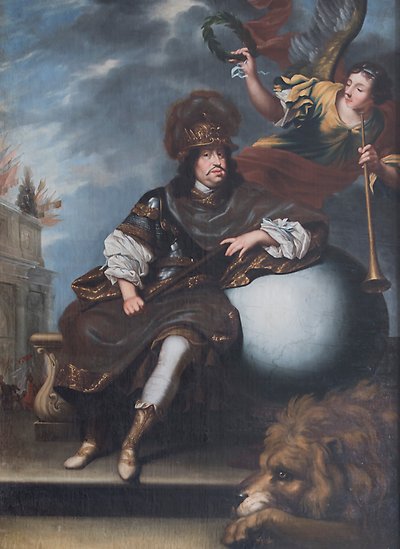
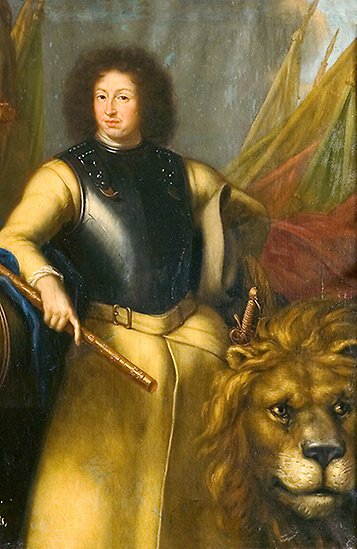
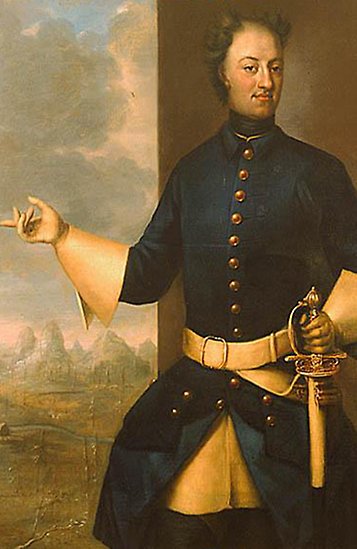
.jpg)
